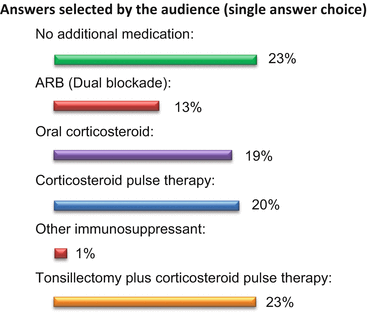Fig. 8.1
Answers selected by the audience for Case 1
In January 2014, BP 124/68, proteinuria 1.5 g/day, urinary RBC 5-9/HPF, eGFR 55 mL/min/1.73 m2. Renal biopsy: acute lesion (endocapillary hypercellularity) (+), chronic lesion (+). In May 2014, BP 124/68, proteinuria 1.5 g/day, urinary RBC 5-9/HPF, eGFR 55 mL/min/1.73 m2.
Case 2
48-year-old female with no medication (see Fig. 8.2 for the questionnaire result)


Fig. 8.2
Answers selected by the audience for Case 2
In November 2013, BP 128/78, proteinuria 1.8 g/day, urinary RBC11-20 /HPF, eGFR 100 mL/min/1.73 m2. Renal biopsy: acute lesion (endocapillary hypercellularity) (+). After 6 months of medication with ACEI, in May 2014, BP 118/70, proteinuria 1.2 g/day, urinary RBC 11-20/HPF, eGFR 100 mL/min/1.73 m2.
References
1.
Berger J, Hinglais N. Intercapillary deposits of IgA-IgG. J Urol Nephrol. 1968;74:694–5.
3.
Berthoux F, Mohey H, Laurent B, Mariat C, Afiani A, Thibaudin L. Predicting the risk for dialysis or death in IgA nephropathy. J Am Soc Nephrol. 2011;22:752–61.CrossRefPubMedPubMedCentral
4.
5.
Suzuki H, Kiryluk K, Novak J, Moldoveanu Z, Herr AB, Renfrow MB, et al. The pathophysiology of IgA nephropathy. J Am Soc Nephrol. 2011;22:1795–803. doi:10.1681/ASN.2011050464.CrossRefPubMedPubMedCentral
6.
7.
Radhakrishnan J, Cattran DC. The KDIGO practice guideline on glomerulonephritis: reading between the (guide)lines—application to the individual patient. Kidney Int. 2012;82:840–56. doi:10.1038/ki.2012.280.CrossRefPubMed
8.
10.
11.
Dillon JJ. Angiotensin-converting enzyme inhibitors and angiotensin receptor blockers for IgA nephropathy. Semin Nephrol. 2004;24:218–24.CrossRefPubMed
< div class='tao-gold-member'>
Only gold members can continue reading. Log In or Register to continue
Stay updated, free articles. Join our Telegram channel

Full access? Get Clinical Tree






